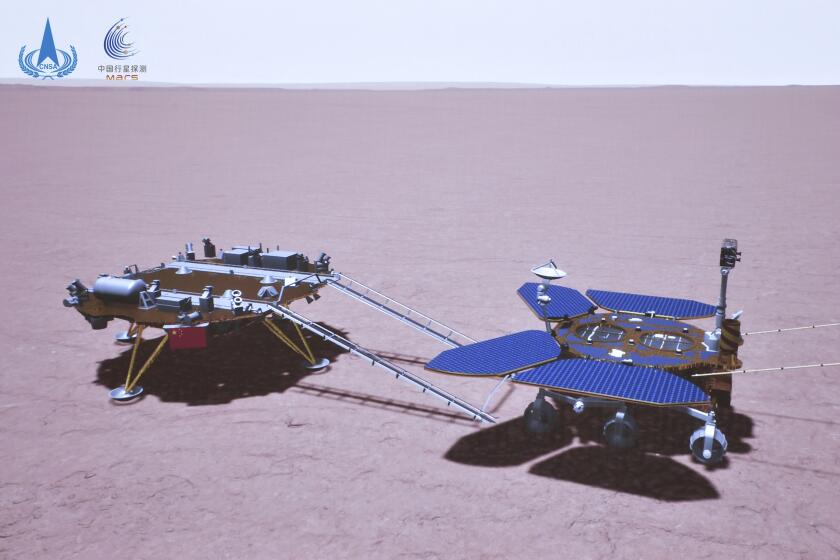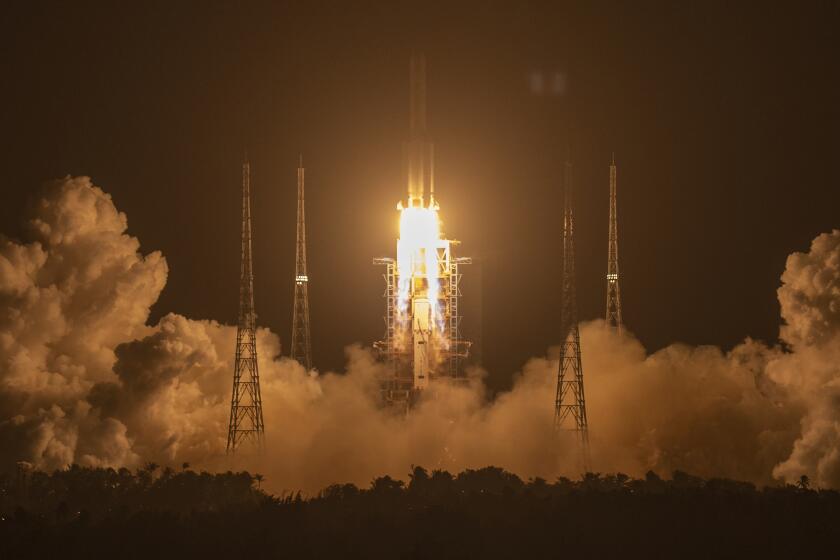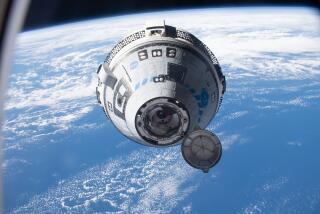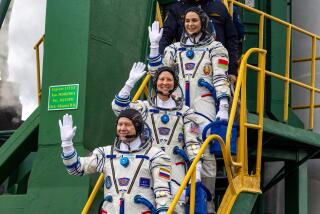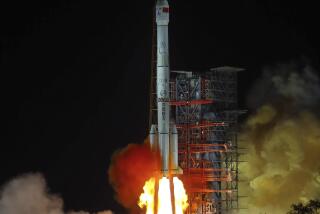China’s Shenzhou-13 spacecraft docks for 6-month mission
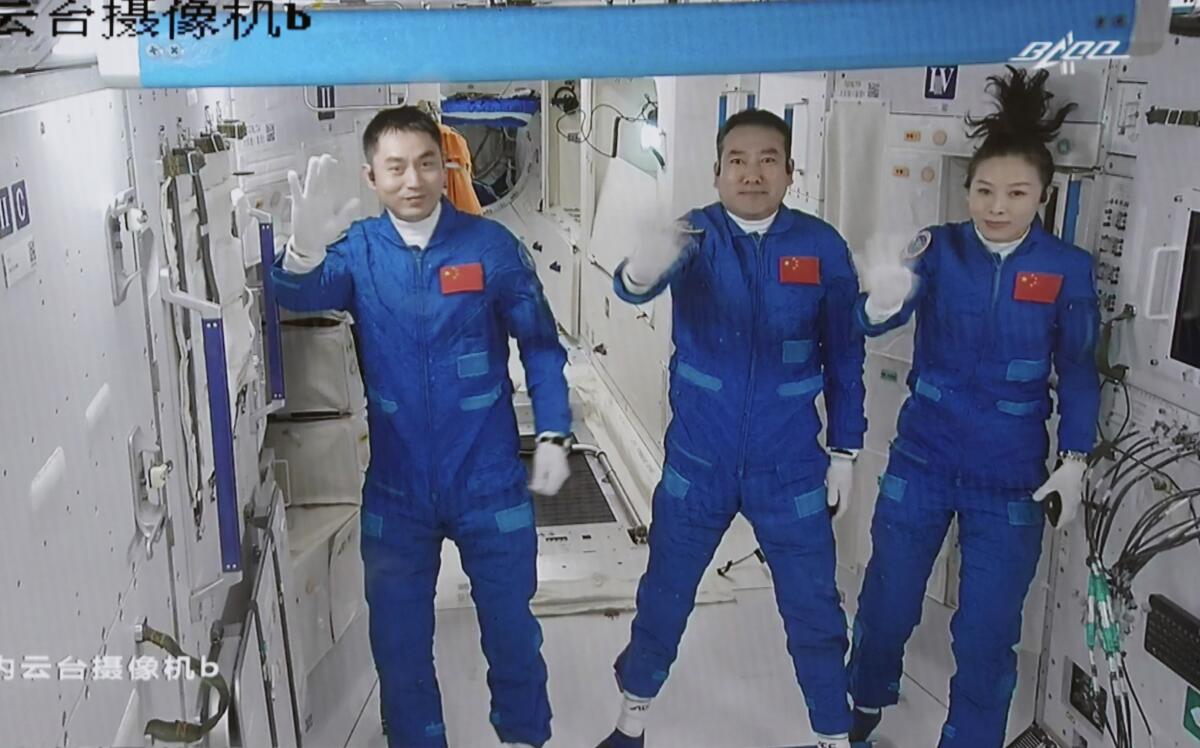
- Share via
BEIJING — Three astronauts entered China’s space station for a six-month mission, setting to work Saturday after successfully docking aboard their Shenzhou-13 spacecraft.
The astronauts, two men and a woman, were seen floating around the module before speaking via a live-streamed video. They pledged to do their best in carrying out their missions.
The spacecraft was launched by a Long March-2F rocket at 12:23 a.m. Saturday and docked with the Tianhe core module of the Tiangong space station at 6:56 a.m., approximately 6½ hours later.
The three astronauts entered the Tianhe space station core module at about 10 a.m., the China Manned Space Agency said.
They are the second crew to move into the space station, which was launched last April. The first crew stayed three months.
China’s solar-powered Mars rover drove down from its landing platform Saturday and is now roaming the red planet, officials said.
The new crew includes two veterans of space travel, Zhai Zhigang, 55, and Wang Yaping, 41. Ye Guangfu, 41, is making his first trip to space.
“We’ll cooperate with each other, carefully conduct maneuvers, and try to accomplish all tasks successfully in this round of exploration of the universe,” said Wang in the video.
Wang is the first Chinese woman to board the Tiangong space station, and is also expected to become the China’s first female spacewalker.
They were seen off by a military band and supporters singing “Ode to the Motherland,” underscoring the national pride invested in the space program, which has advanced rapidly in recent years.
The crew will do three spacewalks to install equipment in preparation for expanding the station; assess living conditions in the Tianhe module and conduct experiments in space medicine and other fields.
China’s military-run space program plans to send multiple crews to the station over the next two years to make it fully functional.
When completed with the addition of two more sections — named Mengtian and Wentian — the station will weigh about 66 tons, much smaller than the International Space Station, which launched its first module in 1998 and weighs around 450 tons.
Two more Chinese modules are due to be launched before the end of next year during the stay of the yet-to-be-named Shenzhou-14 crew.
China and Russia plan to build a lunar research station, possibly on the moon’s surface, marking the start of a new era in their space cooperation.
China’s Foreign Ministry on Friday renewed its commitment to cooperation with other nations in the peaceful use of space.
Spokesperson Zhao Lijian said sending humans into space was a “common cause of mankind.” China would “continue to extend the depth and breadth of international cooperation and exchanges” in crewed spaceflight and “make positive contributions to the exploration of the mysteries of the universe,” he said.
China was excluded from the International Space Station largely due to U.S. objections over the Chinese program’s secretive nature and close military ties, prompting it to launch two experimental modules before starting on the permanent station.
U.S. law requires congressional approval for contact between the American and Chinese space programs, but China is cooperating with space experts from other countries including France, Sweden, Russia and Italy. Chinese officials have said they look forward to hosting astronauts from other countries aboard the space station once it becomes fully functional.
China has launched seven crewed missions with a total of 14 astronauts aboard — two have flown twice — since 2003, when it became only the third country after the former Soviet Union and the United States to put a person in space on its own.
China has also expanded its work on lunar and Mars exploration, including landing a rover on the little-explored far side of the Moon and returning lunar rocks to Earth for the first time since the 1970s.
This year, China also landed its Tianwen-1 space probe on Mars, whose accompanying Zhurong rover has been exploring for evidence of life on the red planet.
Other Chinese space programs call for collecting soil from an asteroid and bringing back additional lunar samples. China has also expressed an aspiration to land people on the moon and possibly build a scientific base there, although no timeline has been proposed for such projects. A highly secretive space plane is also reportedly under development.
More to Read
Sign up for Essential California
The most important California stories and recommendations in your inbox every morning.
You may occasionally receive promotional content from the Los Angeles Times.
